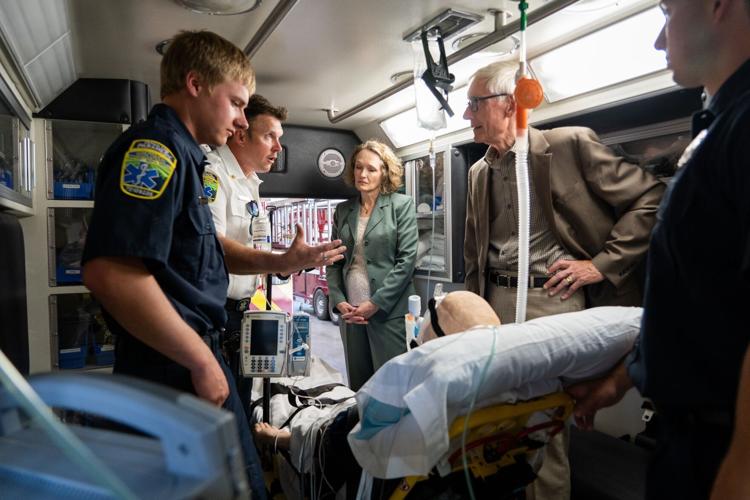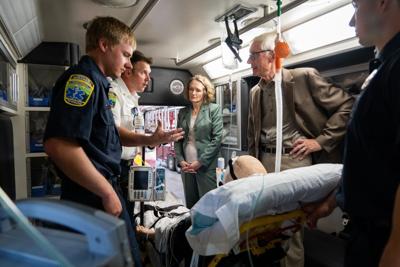James Small’s father was a firefighter. Growing up, he spent time at the fire station around other firefighters.
“It just became natural,” Small said. “When I was in high school, they were running a first responder class … and here I am.”
Small, the new EMS program manager for the Wisconsin Office of Rural Health, has worked in emergency response since 1993. He’s now working to make Wisconsin’s rural EMS system more sustainable in small towns and villages across the state.
“We know the problem is (that) we don't have enough money, and we don't have enough people,” Small said. “But what is the solution to that? It's very clear that there is a tremendous issue that's only gotten worse.”
Earlier this month, the Wisconsin Office of Rural Health created an EMS outreach program designed to serve rural providers and connect them with resources. Small is currently transitioning out of his position as the police chief, fire chief and EMS service director for the Village of Palmyra in Jefferson County.
Small is also a faculty member at Waukesha County Technical College. And he’s a licensed paramedic, serving part-time in the Western Lakes Fire District in Oconomowoc.
To help EMS in Wisconsin, Small said it’s important to get communities solid data, information and suggestions.
“What kind of research do we need to do to determine some solutions?” Small said. “What would those solutions be, and who would be partners that we could collaborate with to help make those things happen?”

In this archived photo, a Beaver Dam paramedic is inside an ambulance.
‘It’s too much for people to take on’
Across the state, EMS in rural and urban communities have faced financial and staffing struggles. Rural communities have been hit particularly hard.
“We don't have the same financial resources to sustain our agencies that there might be in … more urban areas,” said Amanda Mulvey, emergency management coordinator in Florence County.
Florence County, 490 square miles in northern Wisconsin, has about 4,500 residents. The county’s EMS is 100% volunteer run.
Along with her role as emergency management coordinator, Mulvey is also an EMT coordinator, a nonprofit ambulance service director and a registered nurse. Like Small, she comes from a family of emergency service providers.
“Emergency services, volunteering, is something that my father and my grandfather before him had done in the fire service,” Mulvey said. “I grew up with volunteering for fire and EMS as part of our family’s day to day life.”
The population in Florence County is largely older adults. When the majority of the population served year-round is elderly, EMS providers make less money due to Medicare and Medicaid caps.
“There's a cap on what we're allowed to receive for payments,” Mulvey said. “That makes a big difference on our bottom line when we're billing for less than 400 to 450 calls per year as a county as a whole.”
Another major element that impacts Florence County is recreation and tourism.
“When we see a large influx in tourism — our populations double, if not triple in the summer months — our challenges are the short staffing,” Mulvey said. “Those folks come into the area for relaxation, tourism and enjoyment, but that's not part of our volunteer pool. Sustaining our volunteer agencies has been difficult.
“Many people volunteer over and above their full time positions, and there's burnout because it's too much,” she added. “It's too much for people to take on.”
9-1-1 provides a sense of security, but in some rural communities help isn’t always on the way.

In this archive photo from 2013, Madison Area Technical College paramedic class students prepare to load a simulated patient into an ambulance inside the campus' Protective Services building.
The ‘free trial’ is over
In the 1960s, prior to the widespread use of emergency medical services across the country, 50% of ambulance services were provided by morticians. With the goal of improving and organizing critical first-response care, congress created the EMS Systems Act in 1973 to send grant money to states to develop regionally based EMS providers.
This also marked the creation of the Division of Emergency Medical Services and allocated $300 million to improve EMS in the U.S. EMS providers emerged across the country, but five years later, in 1978, federal funding stopped coming.
States weren’t prepared to inherit the financial responsibility of EMS. Lack of infrastructure led to unstable funding and the shift of services to the local level.
EMS providers were left without structure, direction or resources. When urban EMS began to develop, rural EMS fell behind. The providers didn’t have the same access to resources due to smaller populations and fewer calls per year, which means less funding.
Small said EMS is at a turning point, and it’s time to rethink how EMS is operated.
“It's been normalized that there'll be volunteers there, and nobody really stopped to question that,” Small said. “It's almost like they said, ‘You know what, here's our free trial.’ And then for 50 years we ran this free trial.”
In that time, emergency services became a vital part of communities, but “the free trial is over,” Small said. So “how do we create this sustainable thing going forward so that we can afford it, and it's still providing reliable service?”
Limits of grants
In Florence County, Mulvey described the state of EMS funding as “bleak.” Her rural community of less than 5,000 simply doesn’t have that much spending power. There’s a phrase she’s heard — “we’re expected not only to do it for nothing, but with nothing,” Mulvey said.
In Wisconsin, EMS is considered an essential service only in towns. However, most communities work to provide EMS, even when sufficient funding and access to resources is not available. In these cases, departments often contract with neighboring communities to provide service.
Grant funding provides a lot of financial aid to rural EMS, but many smaller EMS providers are not eligible for grants due to the amount of service they provide. Or they don’t have the resources to obtain substantial grant funding — like access to professional grant writers or the funds to hire one.
Federal Flex Grant and the American Rescue Plan Act funding are sending dollars to Wisconsin EMS, but Mulvey said this type of support is flawed.
“Anytime we can breathe for a little bit and have the funding we need it's appreciated, but … behind it comes this other struggle,” Mulvey said. Funding runs out before the need does — necessary tools like medications and cardiac monitors are “so expensive,” she said.
“Most of our rural communities can't afford to upgrade those things.”
Some rural communities have taken matters into their own hands. In Florence County, residents worked with the Wisconsin Office of Rural Health and neighboring providers. Together they created a plan to maintain emergency services.
While community-level problem solving is an option for some rural EMS providers, there is more work to do when it comes to building ‘EMS 2.0.’
EMS across the country, both rural and urban, need sustainable funding and are struggling to staff departments. But rural communities are facing unique financial challenges.
“Where we might do 400 to 450 transports per year across the county, those agencies might do that in a month's time,” Mulvey said. “But at the end of the day, the training requirements, the licensure requirements are all the same.
“The state of Wisconsin doesn't look at us in rural Wisconsin, and say, ‘We're going to be a little bit more relaxed with what you're required to do,’” she said. “And we wouldn't want them to. Our residents are entitled to the same care across the state of Wisconsin.”






